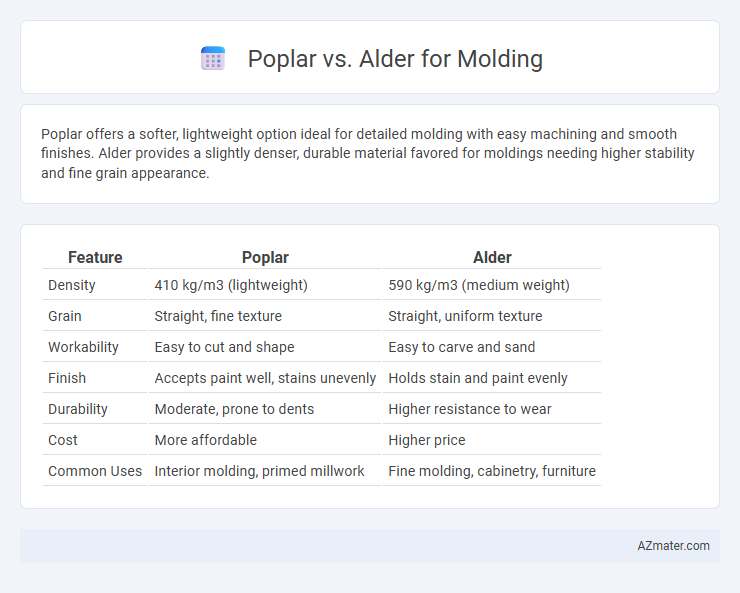Poplar offers a softer, lightweight option ideal for detailed molding with easy machining and smooth finishes. Alder provides a slightly denser, durable material favored for moldings needing higher stability and fine grain appearance.
Table of Comparison
| Feature | Poplar | Alder |
|---|---|---|
| Density | 410 kg/m3 (lightweight) | 590 kg/m3 (medium weight) |
| Grain | Straight, fine texture | Straight, uniform texture |
| Workability | Easy to cut and shape | Easy to carve and sand |
| Finish | Accepts paint well, stains unevenly | Holds stain and paint evenly |
| Durability | Moderate, prone to dents | Higher resistance to wear |
| Cost | More affordable | Higher price |
| Common Uses | Interior molding, primed millwork | Fine molding, cabinetry, furniture |
Introduction: Poplar vs Alder for Molding
Poplar and alder are popular hardwood choices for molding, each offering unique benefits in woodworking projects. Poplar is known for its affordability, smooth grain, and ease of painting, making it ideal for decorative moldings that require a flawless finish. Alder features a tighter grain and warmer tones, providing durability and a rich, natural look suited for stain-ready molding applications.
Overview of Poplar Wood for Molding
Poplar wood is a popular choice for molding due to its fine, even grain and smooth texture, which makes it ideal for painting and staining. It is lightweight, moderately soft, and easy to machine, allowing for precise cuts and intricate designs. The wood's consistent color and minimal knots contribute to a clean, finished appearance in interior trim applications.
Overview of Alder Wood for Molding
Alder wood offers a smooth, fine grain and consistent texture, making it ideal for detailed molding work. Its natural hardness balances durability with ease of machining, allowing intricate profiles without splintering. Compared to poplar, alder provides a warmer tone and excellent stain absorption, enhancing the aesthetic appeal of interior moldings.
Durability Comparison: Poplar vs Alder
Poplar and alder differ significantly in durability when used for molding projects, with alder offering greater resistance to dents and scratches due to its higher density and tighter grain structure. Poplar is softer and more prone to damage, making it less ideal for high-traffic areas or where durability is paramount. For long-lasting molding that withstands wear, alder is the preferred choice over poplar.
Workability and Machinability Factors
Poplar offers excellent workability due to its soft, lightweight nature and smooth grain, making it ideal for detailed molding projects requiring fine finishing. Alder provides superior machinability with consistent cutting performance and less wear on tools, suitable for more intricate profiles and durability in production. Both woods perform well in sanding and staining, but Poplar's ease of shaping contrasts with Alder's enhanced stability during machining.
Aesthetic Differences: Grain and Color
Poplar molding features a relatively smooth and uniform grain with a light cream to pale yellow color, making it ideal for painted finishes or subtle aesthetics. Alder molding displays a straight, fine grain with occasional knots and ranges from light brown to reddish hues, offering a warmer, richer tone that highlights natural wood patterns. Choosing between Poplar and Alder depends on whether a more neutral, paint-friendly look or a warm, stained appearance is desired for interior trim applications.
Finishing and Staining Results
Poplar offers a smooth, even grain that accepts paint and stains well, producing a consistent, vibrant finish ideal for custom-colored molding. Alder, with its richer, reddish-brown tones and tighter grain, stains beautifully to highlight natural wood features, providing a warm, high-end look. Poplar is preferred for projects requiring uniformity and ease of finishing, while Alder excels when a richer, more natural wood aesthetic is desired.
Cost and Availability Analysis
Poplar offers a cost-effective option for molding due to its widespread availability and fast growth, resulting in lower prices compared to alder. Alder, while moderately priced, is less common and often sourced from specific regions, impacting its availability and leading to occasional price fluctuations. Choosing poplar typically ensures more consistent supply and budget-friendly material, making it a preferred choice for large-scale or cost-sensitive molding projects.
Best Uses: When to Choose Poplar or Alder
Poplar is ideal for interior molding applications due to its smooth grain and affordability, making it perfect for painted finishes and detailed work. Alder offers a richer, warmer tone with a fine, uniform grain suitable for stained molding in traditional or rustic interiors. Choose Poplar for budget-friendly, painted trim and Alder when a natural wood appearance with stain is desired.
Conclusion: Selecting the Right Wood for Molding
Poplar offers a smooth, uniform grain and excellent paint adhesion, making it ideal for intricate molding designs and painted finishes, while alder provides a warmer tone and natural stain compatibility suited for stained or natural wood appearances. Consider poplar for cost-effectiveness and durability in high-traffic areas, whereas alder is preferable for projects emphasizing rich color and grain character. Selecting the right wood depends on whether you prioritize paintability and budget (poplar) or natural aesthetics and finish versatility (alder).

Infographic: Poplar vs Alder for Molding
 azmater.com
azmater.com